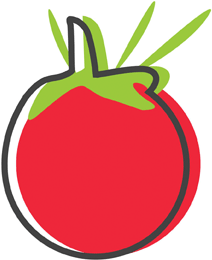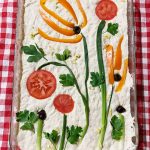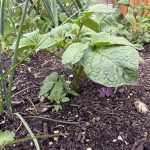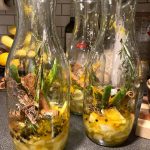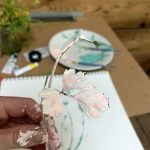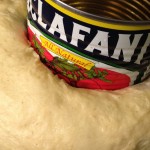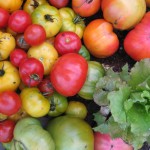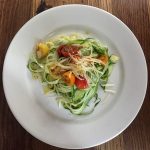by Paula D.
on January 16, 2021 8:58 am in Family
Since reading the article in The Wave two weeks ago about Annie McMahon, I’ve been thinking so much about my cousin Tommy, who also suffered from Cystic Fibrosis.
In the beginning, everything seemed normal with my cousin growing up. My godparents never let on to all the troubles and pain they lived with.
Tommy was my cool, older cousin, always messing around and being nutty. I remember the block parties in Brooklyn, on Herbert street where my great aunt lived. I’ll never forget the time I was running down the street screaming for dear life. Tommy being 8 years older than me, easily caught up, grabbed the back of my shirt and poured a bucket of ice water down my back. I think I was laughing and crying at the same time!
At family parties we would have eating competitions – meatballs, hotdogs, chicken wings or whatever was in the sternos. All the cousins would chant for their favorite. The excitement grew as some of the kids visibly slowed down and the winner became apparent. It was always Tommy or my cousin Steven who won.
I was around 10 or 11 years old. The phone rang in the middle of the night. It was the call. My Mom woke the kids up to tell us the news. Tommy was getting lungs! I remember feeling excited and happy. Before I went back to bed though, I saw my mom sitting at the kitchen table with her rosary beads.
I think we visited Tommy once or twice in the hospital. I don’t remember much about his recovery. We were blessed, his new lungs were not rejected. And things got back to “normal”.
Tommy and my sisters would go out to the city to the Limelight. And he took Maria to her first concert, Nirvana… oh I wish! As I got older we’d also go out to bars, Halloween parties or just hang out at my mom’s house or Tommy’s apartment.
I’m so glad my cousin got to know my husband Matt. Tommy came to his band’s shows sometimes in Brooklyn. I remember once we were driving to Galapagos. We took two cars, I guess there were a lot of us. I turned on a yellow and he followed and got pulled over. He was mad, but didn’t let on too much.
He knew so much about music. And he was hilarious. I swear he could have been a famous radio personality or podcaster. I remember so many times laughing so hard my stomach hurt. He had that gift.
Tommy was at my wedding, this was 2009. He didn’t get up from the table. He was pretty sick again at this point but I know he wanted to be there for me.
I remember once Tommy telling me something to the effect of, “I can’t stand when people complain about being hungover, I’m sick all the time and I can’t do anything about it.” I know he was angry about his circumstances. I think of this a lot, at times when I drink too much. What a waste of time and health.
I participated in Annie’s plunge in 2011, after Tommy passed away the month before on January 21st. People were taking shots to warm up beforehand. I didn’t partake. The adrenaline rush of plunging into 35 degree water was better than any high alcohol could have given me that day. I raised $2,300 and I still feel proud of that.
Tommy was only 38 years old when he passed away. Now that I’m older than he was, it feels so surreal. He was too young. It drives me crazy when I hear people talk about ignoring a birthday or saying negative things about getting old. I always think of my cousin when this happens. I’ll make a light comment, “Well, I’m glad I’m just here on planet earth!” But it’s not a joke. We should be grateful for every day we have. They are so precious.
Diseases like Cystic Fibrosis have a ripple effect on families and friends. I’m thankful to share only a little bit about my cousin with you. There is so much more!
Annie’s has a story too. If you missed this article published a few weeks back, here.
You’ve seen Anthony Medina’s byline in the paper. He’s one of The Wave’s beat reporters. But he’s also an expert Coquito-maker, and this is the second year his family has been selling their version of the holiday beverage.
In Spanish, Coquito means little coconut. It’s a traditional Christmas and New Year’s drink that originated in Puerto Rico. It’s made with Puerto Rican rum, coconut milk, cream of coconut, and sweetened condensed milk. Other spices and flavoring can be added like ginger, anise, nutmeg, cinnamon, or egg yolk.
A few weeks back Anthony came into the office with a few bottles that Ray Vann, The Wave’s Community Editor ordered. It was deadline day, and once the paper was sent to the printer, Ray opened a bottle for us to celebrate with.
After our taste-test, I had to order some for myself. I bought some for my family as gifts and one bottle for myself. Anthony delivered the coquito beautifully wrapped and it came with shot glasses. This drink is meant to be sipped slowly.
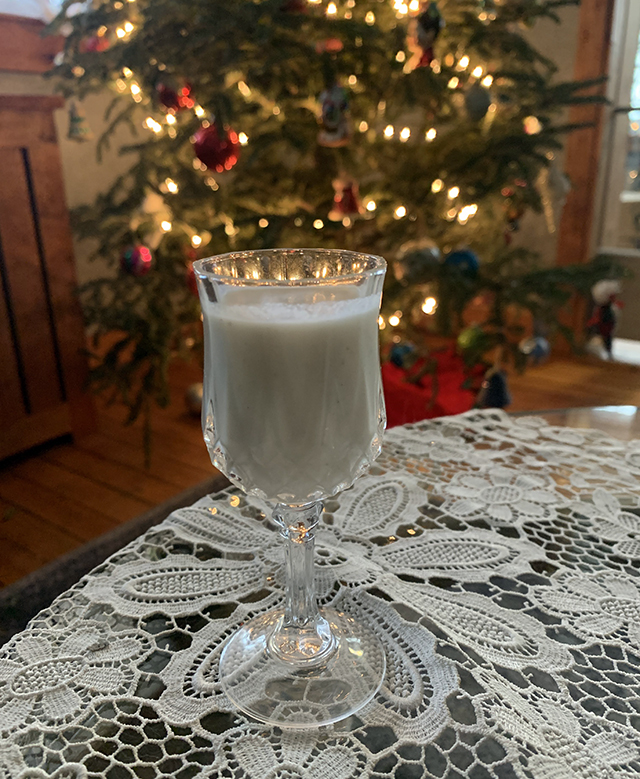
I opened mine on Christmas day and enjoyed it in front of the Christmas tree with my new Mariah Carey Christmas record spinning. The Medina coquito is strong but not overbearing. It is rich and creamy with coconut overtones. There’s a kick and spice but I couldn’t’ exactly place those flavors … delicious. I’m only bothered that I didn’t order several more bottles!
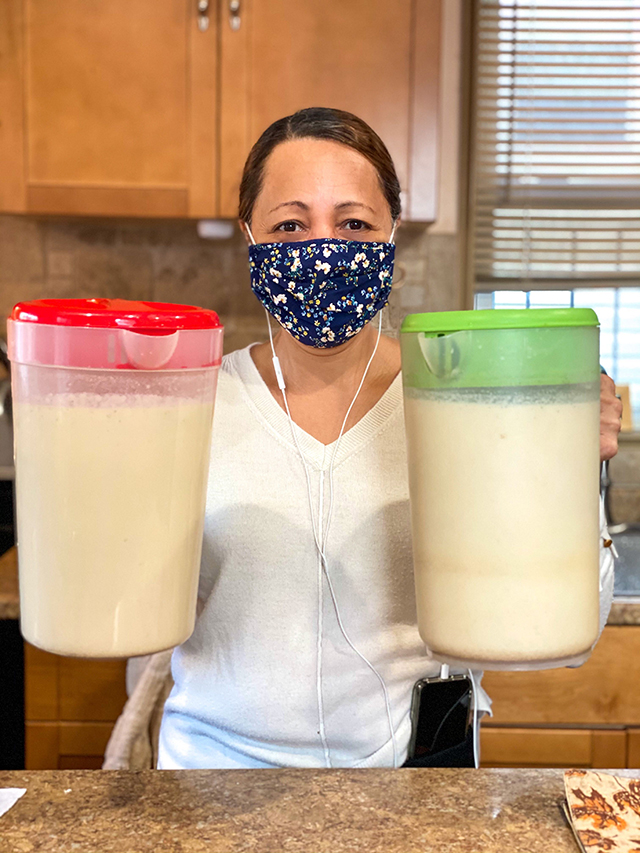
Elizabeth Medina whipping up two batches. Photo courtesy of Anthony Medina
The Medinas are 100% Puerto Rican and Anthony’s mother Elizabeth Medina has been making coquito for over 30 years. The family prides itself on using the best, most authentic procedures, and ingredients.
“Our Coquito recipe is a combination of Puerto Rican minds, my mother says. It comes from my great grandmother who had a passion for coquito and taught my mother,” Anthony told me. “It’s gone through some changes in terms of where the ingredients come from, but the basics stay the same. She also doesn’t use eggs. That’s what really makes it stand out from eggnog.”
No corners are cut, and that’s why the Medina family recipe tastes so great!
I was curious about the name of their product, “Coquito Coño”, Anthony said, “The name Coquito Coño was something that came together in a playful way. The second word there is somewhat of a profanity. We wanted to establish how people would react when they took a sip. The translation is something close to “damn.” People would say “Coño this Coquito is good.”
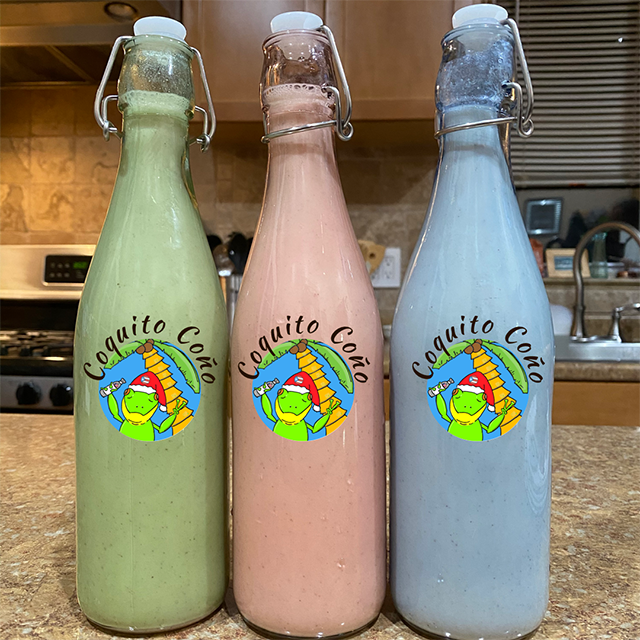
As for many small businesses, this year was a tremendous challenge for the Medina coquito enterprise. Despite this, the family wanted to continue their coquito tradition regardless of the cost benefit. “We still wanted to sell, knowing everyone was going through hardships and needed a little distraction from our grim reality. Coquito is really a comfort drink and something to humble the soul, so anytime we’re making it, we’re just trying to make people enjoy the most of their lives.”
While orders are finished for this holiday season, check out Medina’s new website coquitocono.wordpress.com for more background on this special family recipe.
by Paula D.
on December 31, 2020 1:16 pm in Plants
Monica Glynn, my work friend and The Wave’s Administrative Associate, asked me last week knowing I’m a “plant person,” “What’s the history of mistletoe?” Umm… I actually have know idea,” I said. We both thought, “This would be a timely column.”
I remember the mistletoe in my home growing up as a kid. It wasn’t fancy, the exact opposite actually. Our mistletoe was a round ball made of hard plastic leaves and red berries. It had a vine of more plastic leaves that my father would hang from the light fixture in our kitchen. Why the kitchen and not the traditional doorway location? I’m guessing we had the most foot traffic in the kitchen and so, that would be the easiest location to snag multiple kisses!
On my quest to answer Monica’s question about the significance of mistletoe, I learned from the almighty internet the most interesting of facts that reveal the plant’s symbolism.
Mistletoe is an obligate hemiparasitic plant – meaning a parasitic organism that lives on host plants. So it can’t reproduce without its host. In this case, mistletoe is keen on apple, oak, maple, elm, pine, and birch trees.
Mistletoe is an evergreen, producing berries in the winter. They’re quite attractive, revealing themselves on bare trees and against white snow. Celtic Druids of the 1st century A.D. believed that this plant’s ability to produce its fruit despite frozen winter temperatures was a sign of fertility. So they used mistletoe medicinally on themselves and animals. So many Christian traditions are founded on pagan mysticism and this too is one of them, in a modified form.
There are other references to the origins of the luck and love mistletoe bestows in Norse folklore. How these ancient customs extended to modern day is up for debate. The custom continued through the Middle Ages in various forms to the 18th century, transforming from sacred herb to a holiday decoration.
It is thought that the tradition of kissing under the mistletoe started among servants in England before extending to the middle classes. It is said that men were allowed to steal a kiss from anyone caught under the herb and if the women refused, it was bad luck. I wonder who came up with that one…

My friend Matt Johnson adorned his St. Nicholas garb for a caroling event this past weekend. Mistletoe would have been perfect for his beard and staff but his adornments are beautiful nonetheless.
Wishing all of you a Merry Christmas and a Happy New Year filled with love and good fortune!
by Paula D.
on December 31, 2020 1:08 pm in Food
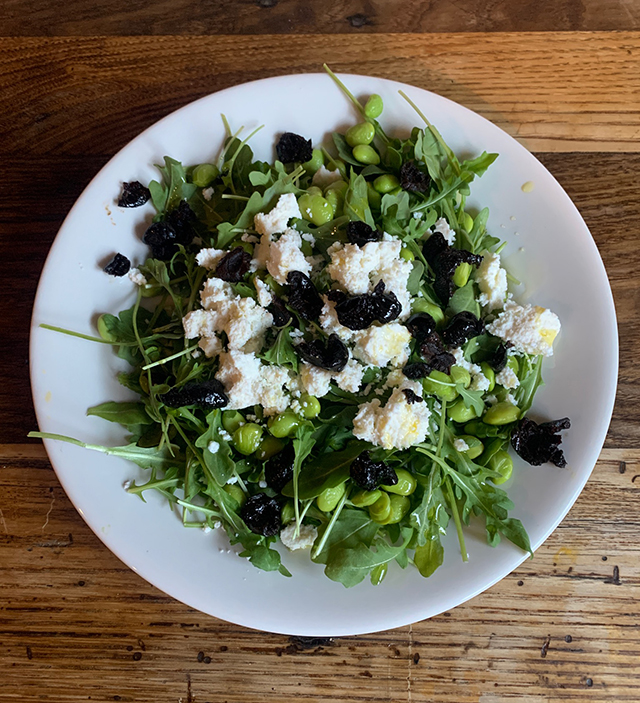
I’m hungry and I open the fridge but I know it’s empty. I’m too cold and lazy to drag my starved body out the door to Key Food. My eyes scan the shelves and I pull out what I can find. Baby arugula, slightly wilted, edamame unopened, queso fresco (white cheese) – it’s been in there for a while but seems to smell fine. On the side of the fridge door I find black oil-cured olives (my favorite olive).
“This will do!”
I add all the ingredients into a bowl with salt, pepper, garlic powder, extra virgin olive oil and a splash of white vinegar.
Out of necessity, I invented a fantastic, unorthodox salad. It’s simple with minimal ingredients and that’s what makes it so tasty and easy to whip up.
The edamame gives the salad a hardiness. The flavor is basic which works well with the bold flavor of the cured olives. I’ve been really into edamame lately. The name translates to “stem beans.” Edamame are immature soybeans. Soy is naturally rich in protein and contains amino acids. It’s also rich in plant fats which is why you feel full after eating soy and that’s perfect for salads and dieting.
I’ve been using black oil-cured olives for at least a decade as my secret ingredient in many dishes. The olives are rich, salty and full bodied in flavor. This is why they’re ideal as a meat substitute in sauces and soups or for a pop of flavor in a salad. The Moroccan variety is the best by far, if you can find them. I buy mine around town (mostly not labeled as Moroccan ) but still good. Sorrentino’s Market ( 99-20 Rockaway Beach Blvd.) sells oil-cured olives regularly as does Bon Appétit (418 Beach 129th St.). Sometimes I see them in Key Food on 87th and the Blvd. but not always.
I’ve only started buying queso fresco. I picked it up for a layered bean dip I was making recently. The price is right, it’s only XX for XX oz. Since then I’ve been using it on everything – eggs, salads, over grilled vegetables. The creamy texture and mild flavor works for many dishes. There are several varieties of this Latin American cheese based on the region. The soft cheese with the rich punch of the black oil-cured olives is what makes this salad fantastic.
Try my newly invented salad and let me know what you think…
Paula’s Edamame Olive Salad
Ingredients (All equal parts):
Baby arugula
Edamame
Queso fresco
Extra virgin olive oil
White vinegar
Salt, pepper, garlic powder to taste
Directions: Pit the cured black olives. Combine all the ingredients. Use your discretion as far as the measurements. If you’re making in advance, wait to dress the salad before you serve it. After adding the oil and vinegar, give it a good mix so the cheese breaks down and becomes part of the dressing.
As an aside, I love the idea that this salad includes, Asian soy beans, Spanish white cheese and Morrocan cured olives, a cultural mix!








